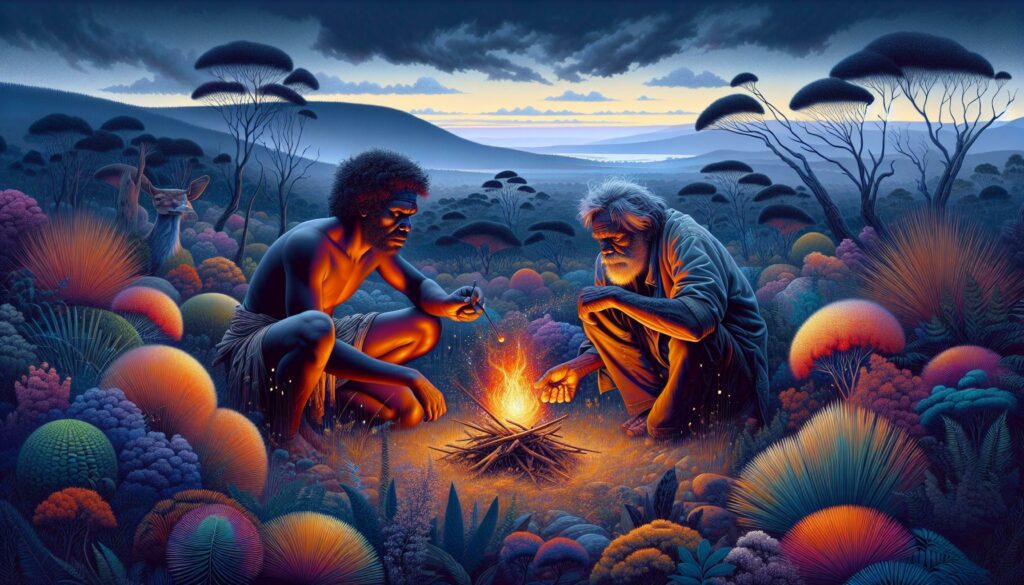Fire has always held a pivotal place in Aboriginal folklore, embodying both creation and destruction. From the first sparks that lit the darkness to the flames that shaped the land, these stories reveal deep connections between the natural world and spiritual beliefs.
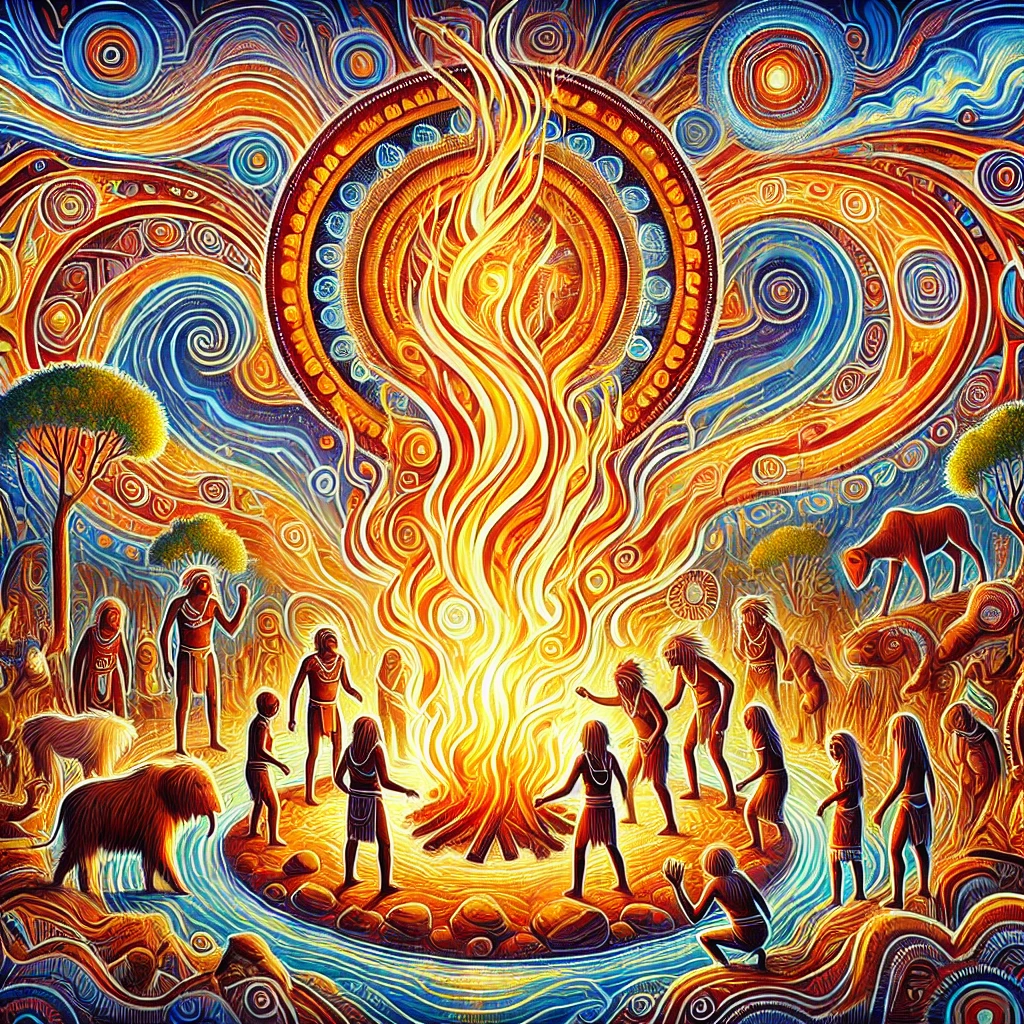
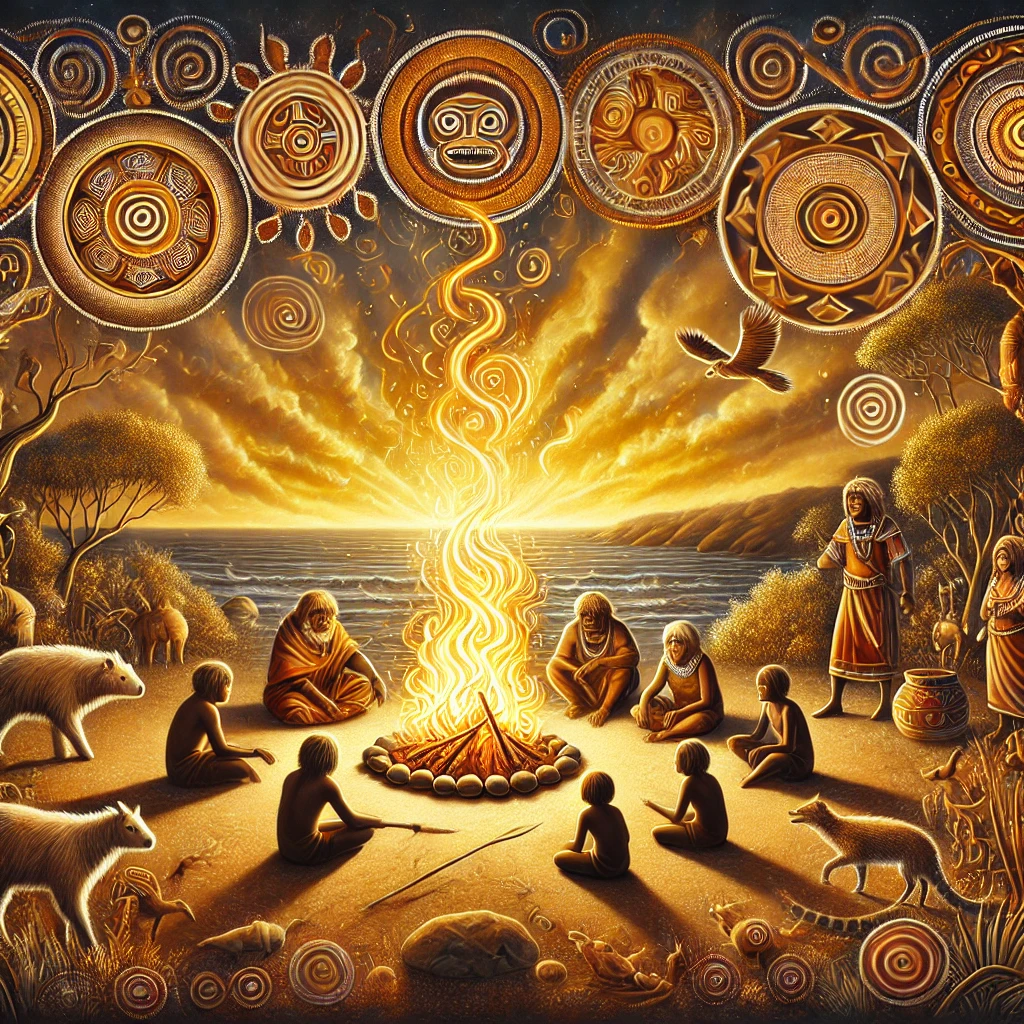
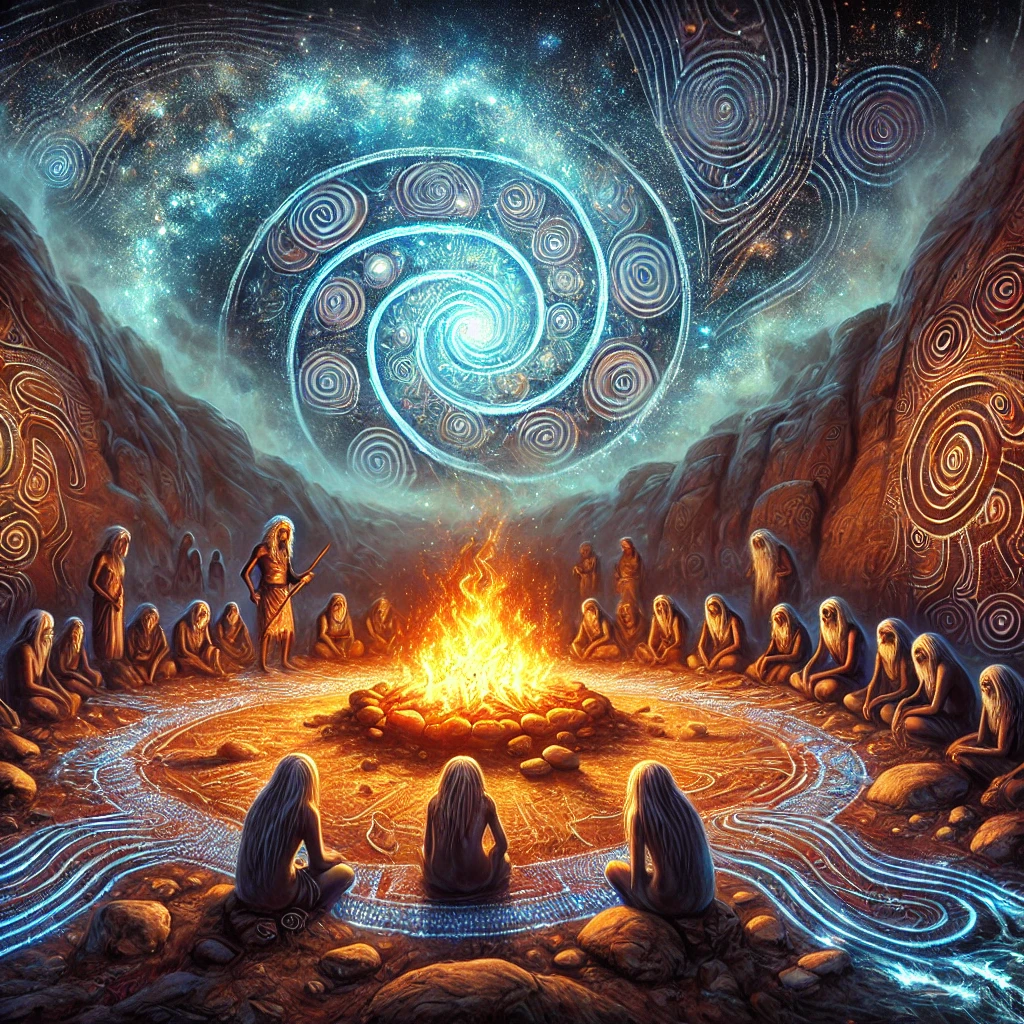
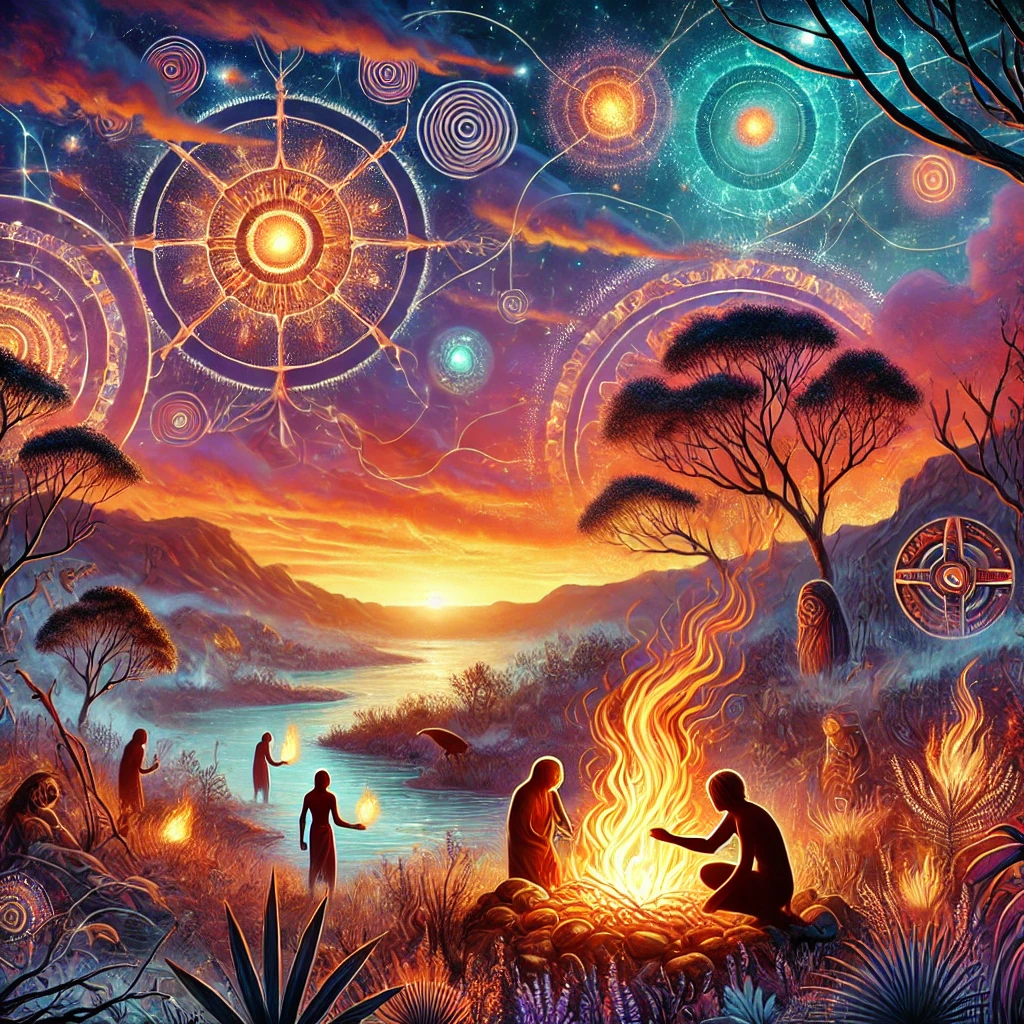
I find it fascinating how these ancient narratives not only explain the origin of fire but also convey lessons about respect, survival, and harmony with nature. Exploring these legends offers a glimpse into the rich cultural heritage and timeless wisdom of Aboriginal communities. Join me as we delve into the captivating story of how fire came to be, illuminating the path of generations past.
Aboriginal Beliefs and Fire
In my study of Aboriginal beliefs, fire emerges as a sacred and vital element. I found that the Tasmanian Aboriginal people, particularly the Oyster Bay Tribe, have a profound legend about the origin of fire. According to their tradition, two black men introduced fire to humanity. These men rested at the base of a hill in ancestral lands and were later seen standing atop the summit by tribal ancestors. They cast fire like a star, which fell among the people, causing fear and prompting them to flee. Subsequently, the men returned and taught the people how to create fire using wood.
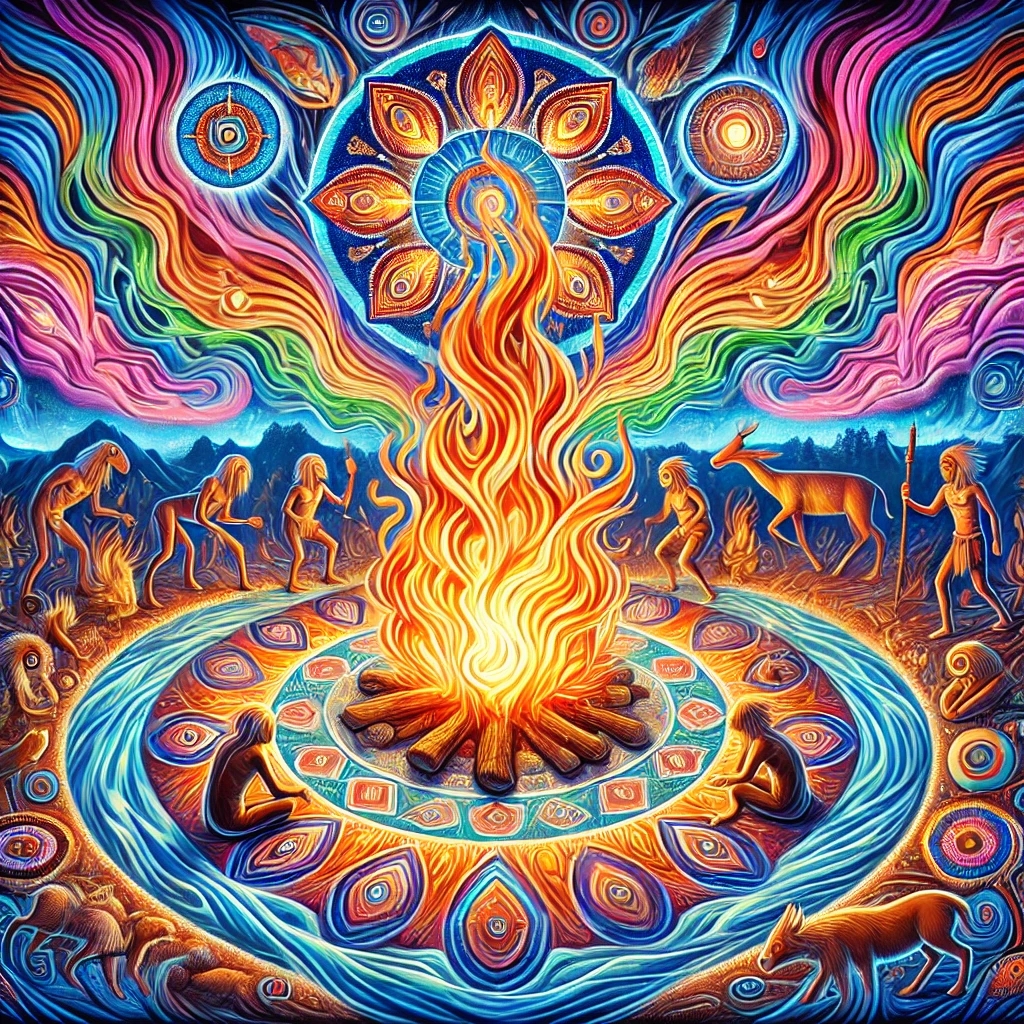
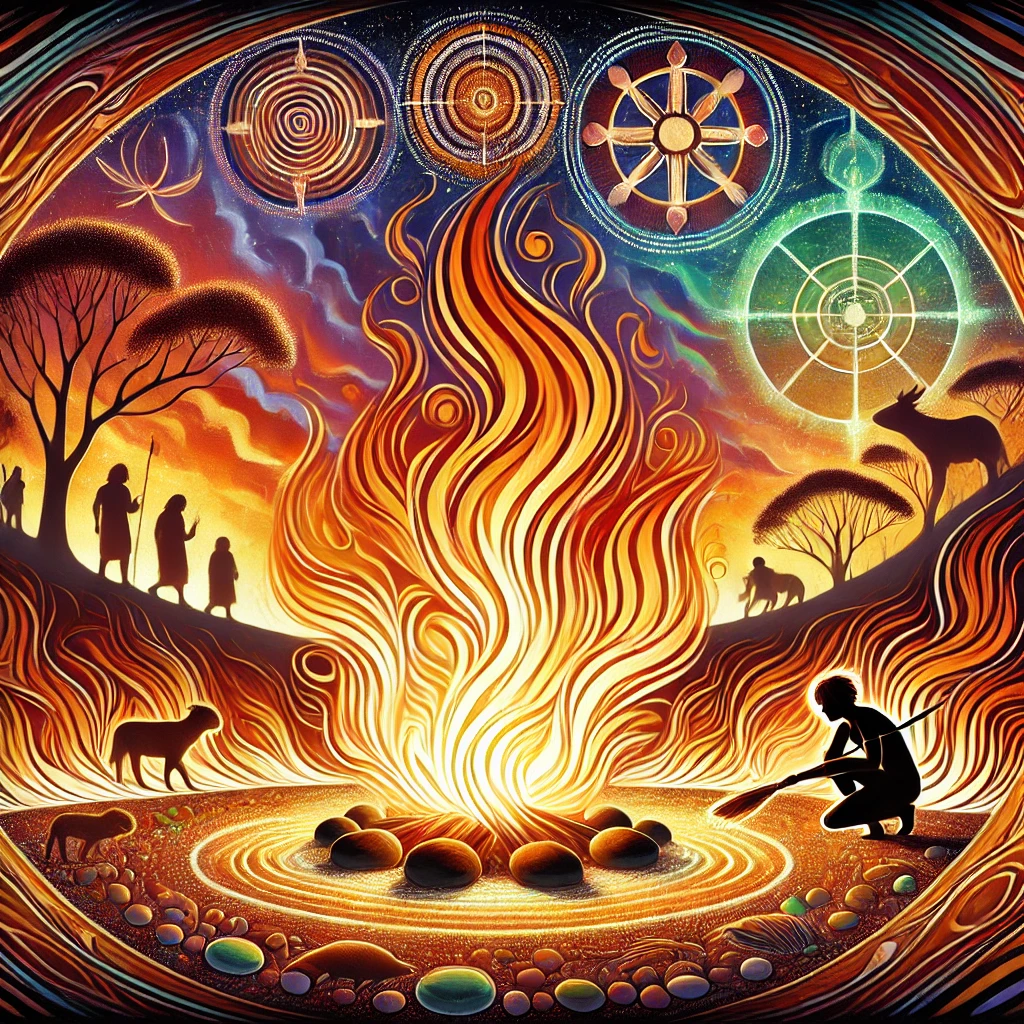
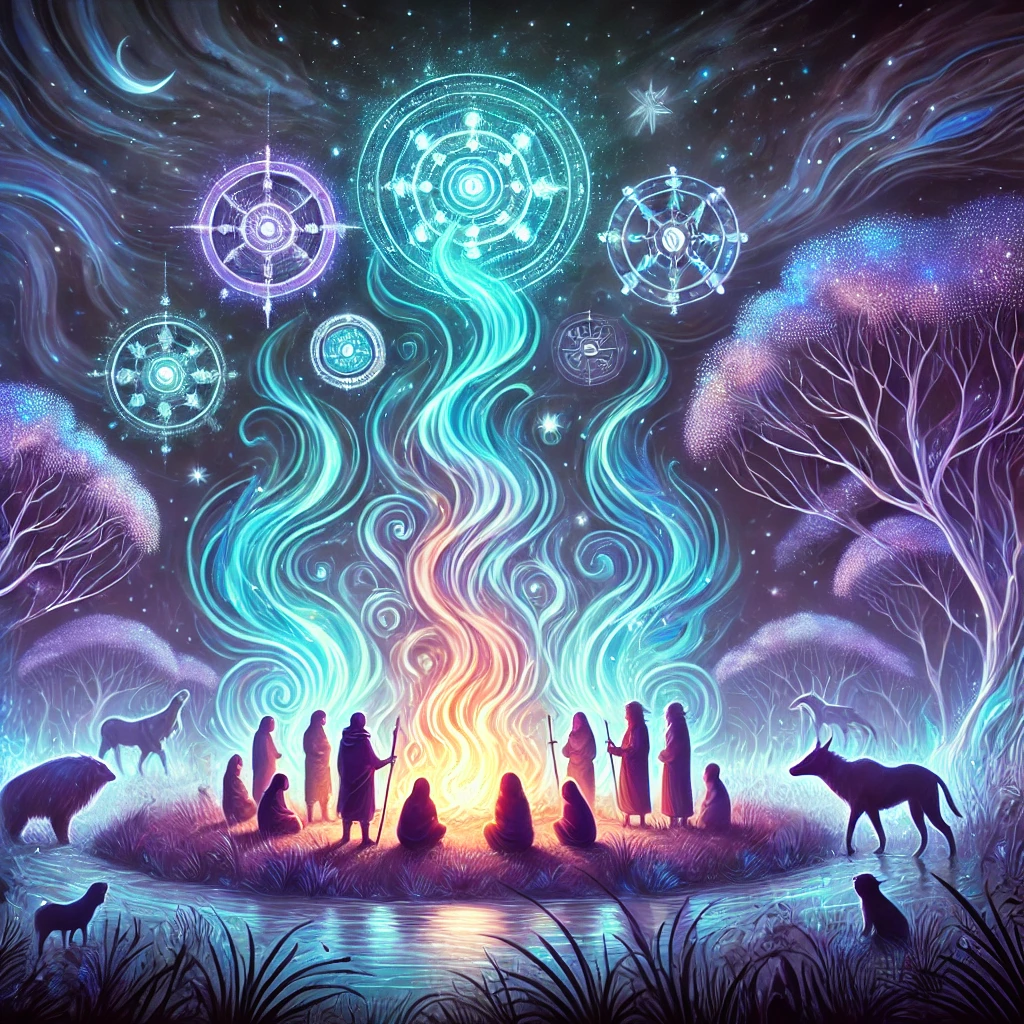
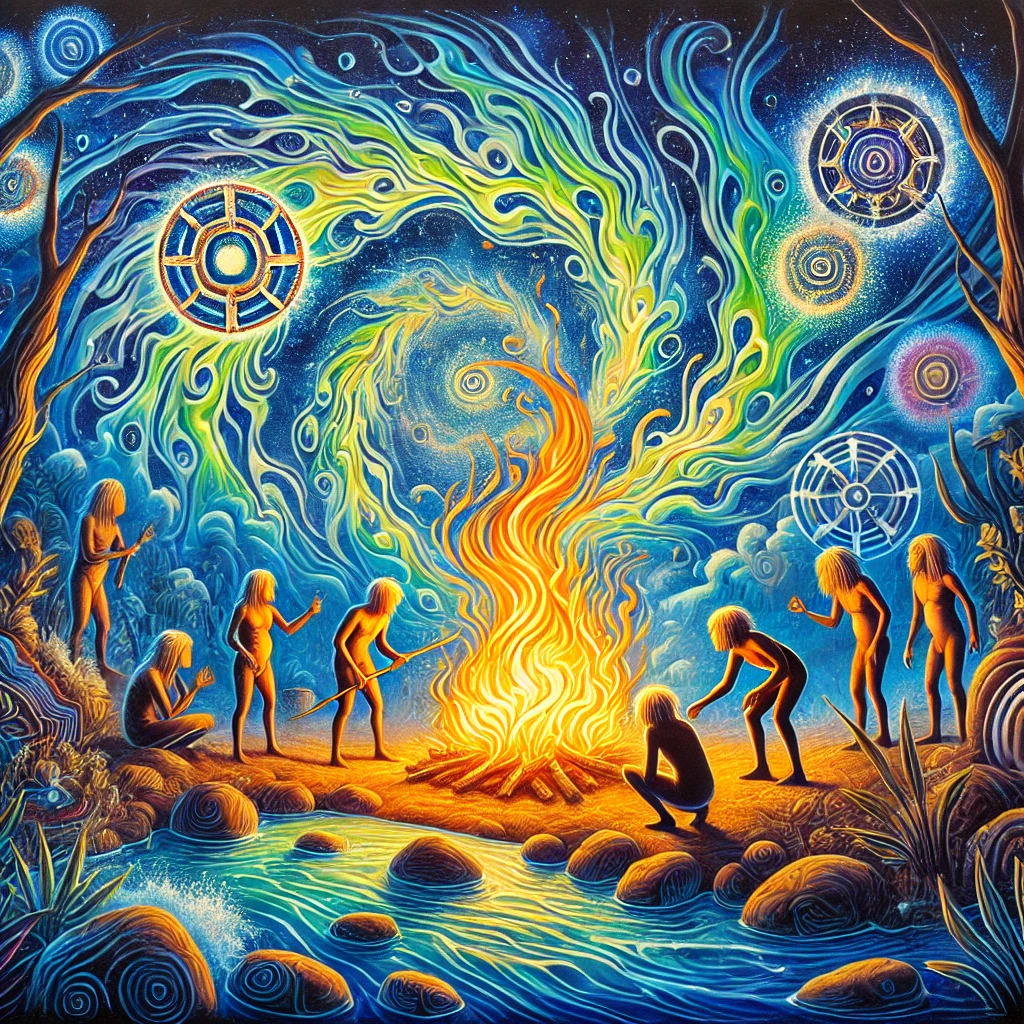
They stayed in the land for a time before ascending to the clouds, where they appear as two stars on clear nights. This narrative highlights fire’s divine origin and its pivotal role in Aboriginal life, symbolising both creation and the balance of nature. I recognise that fire serves not only as a tool for survival but also as a medium for cultural rituals and storytelling, reflecting the deep respect Aboriginal communities hold for this powerful element.
The Origin of Fire Legend
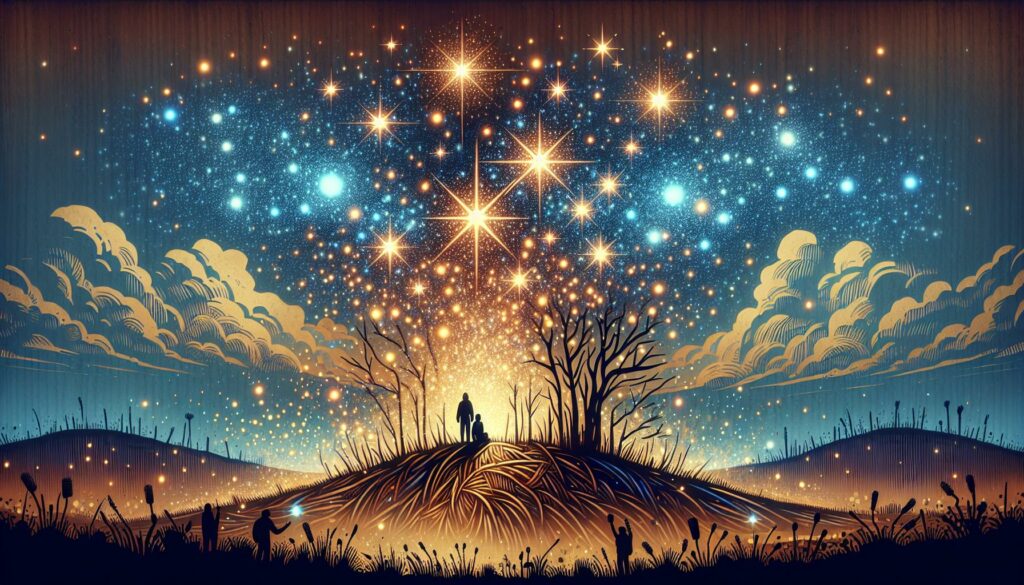
Fire plays a crucial role in Aboriginal folklore, symbolising creation and survival. Various Aboriginal groups share unique narratives that explain fire’s divine origins.
Main Narrative
The Oyster Bay Tribe of Tasmania recounts how two black men introduced fire to their people. These men stood atop a hill, casting fire resembling stars. Fire fell among the Aboriginal communities, initially causing fear. The people then learned to create fire using wood.
Similarly, other Aboriginal legends highlight fire’s sacred emergence, emphasising its essential role in culture and survival. Although not part of Australian Aboriginal folklore, the Ojibwe (Chippewa) tale of Manabozho stealing fire parallels these narratives, illustrating a universal theme of fire’s pivotal importance.
Important Figures
Two black men are central to the Oyster Bay Tribe’s fire origin legend. They bring fire from above, symbolising its divine source. These figures reside in the clouds and appear as two stars on clear nights. Their presence underscores fire’s enduring significance in Aboriginal life.
Additionally, Manabozho from Ojibwe mythology serves as an analogous figure who steals fire, highlighting similar motifs across different cultures.
Cultural Significance of Fire
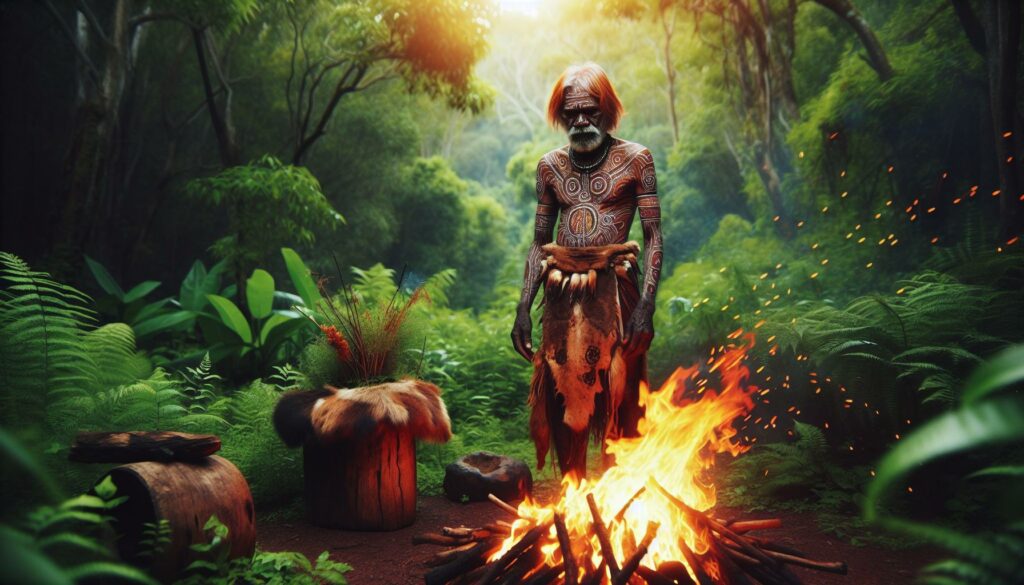
Fire holds a central place in Aboriginal culture, symbolising life, transformation, and continuity. It serves practical purposes, such as cooking, warmth, and protection, essential for daily survival. Additionally, fire plays a pivotal role in cultural rituals and ceremonies, marking important life events and seasonal changes.
Fire is integral to storytelling, with legends like the Oyster Bay Tribe’s origin of fire reinforcing community values and knowledge transmission. These narratives emphasise respect for natural elements and the interconnectedness of all living things. Fire also represents spiritual connection, believed to be a gift from ancestral beings who maintain the balance between the physical and spiritual worlds.
In art and symbolism, fire motifs appear in paintings, carvings, and body art, reflecting its enduring presence in Aboriginal identity. The controlled use of fire, known as “fire-stick farming,” demonstrates sophisticated land management practices, promoting ecological sustainability and biodiversity.
Respect for fire manifests in various cultural practices, ensuring its preservation and harmony within the environment. Elders teach younger generations about fire’s significance, fostering a deep sense of responsibility and stewardship. This reverence for fire underscores its role as a bridge between past, present, and future generations, maintaining the cultural heritage and resilience of Aboriginal communities.
Variations Across Aboriginal Groups
Aboriginal groups across Australia possess unique narratives explaining the origin of fire, each reflecting their distinct cultural and mythological traditions.
Tasmanian Aboriginal Mythology
The Oyster Bay Tribe of the Tasmanian Aboriginal people attributes fire’s origin to two black men who appeared on a hill. These men cast fire resembling a star, which descended among their people. Initially, the fire caused fear, but the community soon learned to harness it for survival. Today, the two figures symbolize fire’s divine gift, visible as two stars on clear nights.
Wurundjeri People of Australia
For the Wurundjeri people, fire’s origin is connected to the Crow. According to their mythology, the Crow stole the secret of fire from the Karatgurk women and introduced it to the people. This act highlights fire’s role as a precious and transformative element within their culture.
| Aboriginal Group | Origin of Fire | Key Figures |
|---|---|---|
| Oyster Bay Tribe | Two black men cast fire from a hill | Two black men |
| Wurundjeri People | Crow stole fire from Karatgurk women | Crow, Karatgurk women |
These diverse stories emphasize fire’s sacred status and its essential role in Aboriginal life, reinforcing each group’s connection to their environment and ancestral heritage.
Modern Perspectives
Contemporary scholars study Aboriginal fire origin stories to understand their cultural significance and ecological knowledge. Researchers highlight how these narratives encapsulate sustainable land management practices, such as fire-stick farming, which promote biodiversity and prevent large-scale wildfires. Additionally, educators incorporate these legends into curricula to teach students about indigenous wisdom and environmental stewardship.
Modern artists draw inspiration from these folklore tales, integrating fire motifs into paintings, sculptures, and performances that celebrate Aboriginal heritage. Museums and cultural centres exhibit artifacts and multimedia presentations that depict the origin of fire, fostering greater public appreciation and respect for Aboriginal traditions.
Environmentalists reference Aboriginal fire practices in developing modern conservation strategies, recognising their effectiveness in maintaining healthy ecosystems. Collaboration between indigenous communities and scientists enhances efforts to combat climate change, leveraging traditional knowledge to implement controlled burns and habitat restoration projects.
Media representations of fire origin myths increase visibility and awareness of Aboriginal cultures, contributing to the preservation of these important stories. Documentaries, books, and online platforms disseminate the rich folklore surrounding fire, ensuring its legacy endures for future generations.
| Aspect | Modern Application |
|---|---|
| Academic Research | Study of sustainable land management and cultural significance |
| Education | Curriculum development incorporating indigenous wisdom |
| Art and Culture | Artistic expressions inspired by fire origin legends |
| Environmental Conservation | Integration of traditional fire practices in modern strategies |
| Media and Representation | Increased visibility through documentaries and publications |
By examining these modern perspectives, the enduring impact of Aboriginal fire origin stories on society, environment, and culture becomes evident, showcasing their relevance in today’s world.
Key Takeaways
- Fire holds a central role in Aboriginal folklore, symbolising both creation and survival.
- The Oyster Bay Tribe’s legend features two black men who introduced fire, highlighting its divine origin.
- Fire is integral to Aboriginal culture through rituals, storytelling, and sustainable land management practices like fire-stick farming.
- Different Aboriginal groups, such as the Wurundjeri, have unique fire origin stories that reflect their distinct cultural traditions.
- Modern applications of these traditions include educational curricula, artistic expressions, and ecological conservation efforts.
- Contemporary recognition of Aboriginal fire practices enhances environmental stewardship and cultural preservation.
Conclusion
Exploring Aboriginal fire origin stories deepened my appreciation for their rich cultural heritage and profound connection with nature. These legends not only illuminate the significance of fire but also highlight timeless lessons on respect and sustainability. Witnessing how traditional practices like fire-stick farming contribute to ecological balance inspires me to value indigenous wisdom in today’s environmental challenges. Embracing these narratives fosters a greater understanding of Aboriginal communities and their enduring resilience. I’m reminded of the enduring power of stories to bridge past and present ensuring that these vital traditions continue to inspire future generations.
Frequently Asked Questions
What is the significance of fire in Aboriginal folklore?
Fire holds a profound place in Aboriginal folklore, symbolising both creation and destruction. It represents life, transformation, and continuity, playing a vital role in survival, cultural rituals, and storytelling. Fire’s dual nature teaches respect for nature and the importance of harmony, reflecting the rich cultural heritage and enduring wisdom of Aboriginal communities.
How does the Oyster Bay Tribe legend explain the origin of fire?
The Oyster Bay Tribe legend recounts that two black men introduced fire to humanity by casting it from a hill. Initially feared, the people soon learned to create fire using wood. This narrative highlights fire’s divine origin and its essential role in survival and cultural practices, underscoring the deep respect Aboriginal communities hold for fire.
What role does fire play in Aboriginal cultural rituals and practices?
Fire is integral to Aboriginal cultural rituals and practices, serving practical purposes like cooking, warmth, and protection. It also features in ceremonies marking life events and seasonal changes. Fire-stick farming, a traditional land management technique, promotes ecological sustainability, while fire motifs in art reflect its spiritual and cultural significance.
How do Aboriginal fire origin stories contribute to modern environmental practices?
Aboriginal fire origin stories inform modern environmental practices by encapsulating sustainable land management techniques like fire-stick farming. These practices promote biodiversity, prevent large-scale wildfires, and maintain healthy ecosystems. Environmentalists and scientists collaborate with indigenous communities to apply traditional knowledge in combating climate change and habitat restoration.
Are there variations in fire origin narratives among different Aboriginal groups?
Yes, different Aboriginal groups have unique fire origin narratives reflecting their distinct cultural and mythological traditions. For example, the Wurundjeri people attribute fire’s origin to the Crow stealing the secret of fire from the Karatgurk women. These diverse stories emphasise fire’s sacred status and illustrate each group’s connection to their environment and ancestral heritage.
How is fire-stick farming related to Aboriginal land management?
Fire-stick farming is a sophisticated Aboriginal land management technique involving controlled burns to promote ecological sustainability. It enhances biodiversity, clears underbrush, and prevents large wildfires. This practice demonstrates Aboriginal knowledge of the environment and their ability to manage landscapes sustainably, ensuring the health and resilience of their ecosystems.
How are Aboriginal fire origin stories preserved and promoted today?
Aboriginal fire origin stories are preserved and promoted through various means, including museums, cultural centres, documentaries, books, and online platforms. Educators incorporate these legends into curricula, while modern artists integrate fire motifs into their work. Collaboration between indigenous communities and scientists also helps document and share these valuable narratives with wider audiences.
How do Aboriginal fire narratives compare to those of other cultures?
Aboriginal fire narratives share universal themes with other cultures, such as the Ojibwe tale of Manabozho stealing fire. Both emphasize fire’s pivotal importance for survival and its divine origins. These similarities highlight the essential role of fire across different societies and underscore the shared human experience of harnessing and respecting this powerful element.
What lessons do Aboriginal fire legends impart about nature and survival?
Aboriginal fire legends teach respect for nature, the importance of balance, and the necessity of harmonious living for survival. They convey lessons on using fire responsibly, maintaining ecological sustainability, and understanding the interconnectedness of all living things. These stories emphasize the wisdom needed to coexist with the environment and ensure the community’s continued well-being.
How do contemporary scholars and educators utilize Aboriginal fire stories?
Contemporary scholars study Aboriginal fire stories to gain insights into cultural significance and ecological knowledge. Educators incorporate these legends into curricula to teach students about indigenous wisdom and environmental stewardship. This integration fosters appreciation for Aboriginal heritage and highlights the relevance of traditional practices in addressing modern ecological challenges.
Author

Josh Morley holds a Bachelor’s degree in Theology from the Trinity School of Theology and a Diploma in Theology from the Bible College of Wales. His academic journey involved interfaith community projects and supporting international students, experiences that shaped his leadership and reflective skills. Now based in Liverpool, Josh is also the founder of Marketing the Change, a digital agency specializing in web design and marketing.
View all posts

